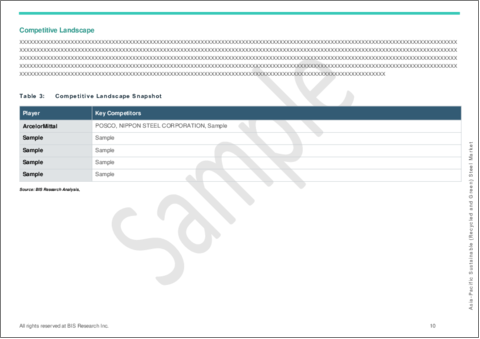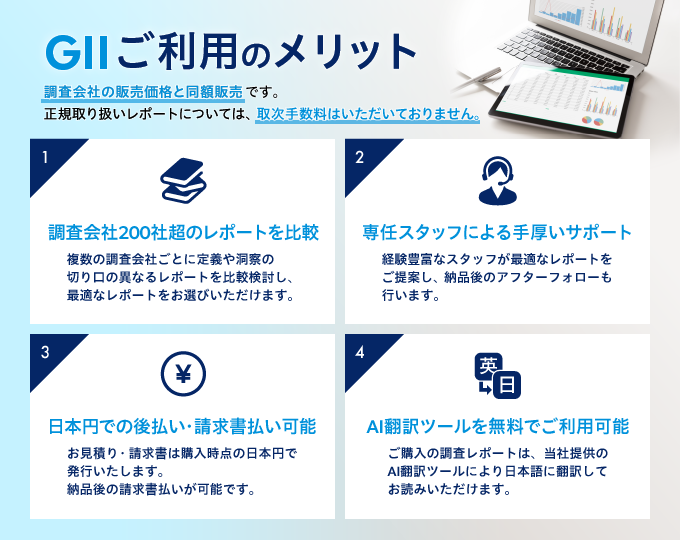|
|
市場調査レポート
商品コード
1643952
アジア太平洋の持続可能な(リサイクル・グリーン)スチール市場:エンドユーザー用途別、製品タイプ別、技術別、国別 - 分析と予測(2024年~2034年)Asia-Pacific Sustainable (Recycled and Green) Steel Market: Focus on End-User Application, Product Type, Technology, and Country-Level Analysis - Analysis and Forecast, 2024-2034 |
||||||
カスタマイズ可能
|
|||||||
| アジア太平洋の持続可能な(リサイクル・グリーン)スチール市場:エンドユーザー用途別、製品タイプ別、技術別、国別 - 分析と予測(2024年~2034年) |
|
出版日: 2025年01月29日
発行: BIS Research
ページ情報: 英文 89 Pages
納期: 1~5営業日
|
全表示
- 概要
- 図表
- 目次
アジア太平洋の持続可能な(リサイクル・グリーン)スチールの市場規模は、2024年に1,756億8,000万米ドルとなりました。
同市場は、10.15%のCAGRで拡大し、2034年には4,618億米ドルに達すると予測されています。アジア太平洋市場は、厳しい環境規制と低炭素建材需要の高まりにより拡大しています。リサイクル手順の改善や水素ベースの還元技術など、スチール生産における技術開発が重要な要因となっています。さらに、戦略的提携やグリーン・インフラ・プロジェクトへの投資を通じて、アジア太平洋スチール業界はより炭素を意識し、持続可能性を高めています。
| 主要市場統計 | |
|---|---|
| 予測期間 | 2024年~2034年 |
| 2024年の評価 | 1,756億8,000万米ドル |
| 2034年の予測 | 4,618億米ドル |
| CAGR | 10.15% |
アジアにおける持続可能な(リサイクル・グリーン)スチール市場は、環境に優しい建材へのニーズの高まりと、厳しい環境規制への対応への圧力の高まりにより、大幅に拡大しています。インフラ、自動車、建設など、この地域の産業がより環境に優しい事業へと移行する中、リサイクル・グリーンスチールの使用は、二酸化炭素排出量を削減し、循環型経済の考え方を推進する重要な手段として浮上しています。
水素を利用した還元法やリサイクル戦略の強化など、スチール生産における技術開発が市場成長の主な促進要因となっています。中国、韓国、日本のような国々が環境に優しいスチール生産プロジェクトに投資する中、水素をベースとしたスチール生産は、従来の方法に代わる低炭素の代替方法として、ますます普及しています。
持続可能なスチールの需要は、アジア太平洋スチール業界のグリーン・インフラ・プロジェクトへの大規模投資によってさらに加速しています。各国政府は、規制、補助金、支援政策を通じてカーボンフットプリントを削減することで、こうした取り組みを奨励しています。
アジア太平洋の持続可能なスチール市場は、環境に優しい建材へのニーズが高まるにつれて拡大し続けると予想されます。同地域が持続可能性の目標を達成し、低炭素の未来へのシフトを推進するためには、グリーンなスチール生産が不可欠となります。
当レポートでは、アジア太平洋の持続可能な(リサイクル・グリーン)スチール市場について調査し、市場の概要とともに、エンドユーザー用途別、製品タイプ別、技術別、国別動向、および市場に参入する企業のプロファイルなどを提供しています。
目次
エグゼクティブサマリー
第1章 市場
- 動向:現在および将来の影響評価
- サプライチェーンの概要
- 研究開発レビュー
- 規制状況
- 主要な世界的出来事別影響分析-COVID-19パンデミック、ロシア/ウクライナ戦争、中東危機が持続可能な(リサイクル・グリーン)スチール市場に与える影響
- 市場力学の概要
- 主要スチールメーカーとネットゼロ目標のリスト
- スタートアップの情勢
- 世界グリーンスチールプロジェクトと開発
第2章 地域
- 地域別概要
- 促進要因と抑制要因
- アジア太平洋
- 地域概要
- 市場促進要因
- 市場抑制要因
- 用途
- 製品
- アジア太平洋(国別)
第3章 市場-競合ベンチマーキングと企業プロファイル
- 今後の見通し
- 地理的評価
- 企業プロファイル
- HBIS GROUP
- NIPPON STEEL CORPORATION
- POSCO
- Tata Steel
- China Baowu Steel Group Corporation Limited
- その他の主要な持続可能なスチールメーカーリスト
- SAIL
- JSW
- Ansteel Group Corporation Limited
- ScrapBuk
- Element Zero
第4章 調査手法
List of Figures
- Figure 1: Asia-Pacific Sustainable (Recycled and Green) Steel Market (by Scenario), $Billion, 2023, 2026, and 2034
- Figure 2: Sustainable (Recycled and Green) Steel Market (by Region), $Billion, 2023, 2026, and 2034
- Figure 3: Sustainable (Recycled and Green) Steel Market, Pricing Analysis (by Region), $/Ton, 2023, 2026, and 2034
- Figure 4: Asia-Pacific Sustainable (Recycled and Green) Steel Market (by End-User Application), $Billion, 2023, 2026, and 2034
- Figure 5: Asia-Pacific Sustainable (Recycled and Green) Steel Market (by Product Type), $Billion, 2023, 2026, and 2034
- Figure 6: Asia-Pacific Sustainable (Recycled and Green) Steel Market (by Technology), $Billion, 2023, 2026, and 2034
- Figure 7: Key Events
- Figure 8: Crude Steel Production and Steel Scrap Consumption, Million Tons, January 2023 to July 2023
- Figure 9: Steel-Produced by Key Manufacturers, Million Tons, 2021-2022
- Figure 10: Tons of CO2 Emissions Per Ton Crude Steel Production as Cast, 2019-2022
- Figure 11: Supply Chain and Risks within the Supply Chain
- Figure 12: Value Chain Analysis
- Figure 13: Patent Analysis (by Number of Patents), January 2020-December 2023
- Figure 14: Patent Analysis (by Country), January 2020-December 2023
- Figure 15: Impact Analysis of Market Navigating Factors, 2023-2034
- Figure 16: Green Steel Projects by Key Manufacturers
- Figure 17: China Sustainable Steel Market, $Billion, 2023-2034
- Figure 18: Japan Sustainable Steel Market, $Billion, 2023-2034
- Figure 19: South Korea Sustainable Steel Market, $Billion, 2023-2034
- Figure 20: India Sustainable Steel Market, $Billion, 2023-2034
- Figure 21: Australia Sustainable Steel Market, $Billion, 2023-2034
- Figure 22: Rest-of-Asia-Pacific Sustainable Steel Market, $Billion, 2023-2034
- Figure 23: Strategic Initiatives, 2022-2024
- Figure 24: Share of Strategic Initiatives
- Figure 25: Data Triangulation
- Figure 26: Top-Down and Bottom-Up Approach
- Figure 27: Assumptions and Limitations
List of Tables
- Table 1: Market Snapshot
- Table 2: Opportunities across Region
- Table 3: Competitive Landscape Snapshot
- Table 4: Trends Overview
- Table 5: Sustainable (Recycled and Green) Steel Market Pricing Forecast (by Region), $/Ton, 2023-2034
- Table 6: Key Regulations/Initiatives in Different Regions toward Net-Zero Emissions
- Table 7: Sustainable (Recycled and Green) Steel Market (by Region), $Billion, 2023-2034
- Table 8: Asia-Pacific Sustainable Steel Market (by End-User Application), $Billion, 2023-2034
- Table 9: Asia-Pacific Sustainable Steel Market (by End-User Application), Million Tons, 2023-2034
- Table 10: Asia-Pacific Sustainable Steel Market (by Product Type), $Billion, 2023-2034
- Table 11: Asia-Pacific Sustainable Steel Market (by Product Type), Million Tons, 2023-2034
- Table 12: Asia-Pacific Sustainable Steel Market (by Technology), $Billion, 2023-2034
- Table 13: Asia-Pacific Sustainable Steel Market (by Technology), Million Tons, 2023-2034
- Table 14: Asia-Pacific Green Steel Market (by Technology), $Million, 2023-2034
- Table 15: Asia-Pacific Green Steel Market (by Technology), Kilo Tons, 2023-2034
- Table 16: China Sustainable Steel Market (by End-User Application), $Billion, 2023-2034
- Table 17: China Sustainable Steel Market (by End-User Application), Million Tons, 2023-2034
- Table 18: China Sustainable Steel Market (by Technology), $Billion, 2023-2034
- Table 19: China Sustainable Steel Market (by Technology), Million Tons, 2023-2034
- Table 20: Japan Sustainable Steel Market (by End-User Application), $Billion, 2023-2034
- Table 21: Japan Sustainable Steel Market (by End-User Application), Million Tons, 2023-2034
- Table 22: Japan Sustainable Steel Market (by Technology), $Billion, 2023-2034
- Table 23: Japan Sustainable Steel Market (by Technology), Million Tons, 2023-2034
- Table 24: South Korea Sustainable Steel Market (by End-User Application), $Billion, 2023-2034
- Table 25: South Korea Sustainable Steel Market (by End-User Application), Million Tons, 2023-2034
- Table 26: South Korea Sustainable Steel Market (by Technology), $Billion, 2023-2034
- Table 27: South Korea Sustainable Steel Market (by Technology), Million Tons, 2023-2034
- Table 28: India Sustainable Steel Market (by End-User Application), $Billion, 2023-2034
- Table 29: India Sustainable Steel Market (by End-User Application), Million Tons, 2023-2034
- Table 30: India Sustainable Steel Market (by Technology), $Billion, 2023-2034
- Table 31: India Sustainable Steel Market (by Technology), Million Tons, 2023-2034
- Table 32: Australia Sustainable Steel Market (by End-User Application), $Billion, 2023-2034
- Table 33: Australia Sustainable Steel Market (by End-User Application), Million Tons, 2023-2034
- Table 34: Australia Sustainable Steel Market (by Technology), $Billion, 2023-2034
- Table 35: Australia Sustainable Steel Market (by Technology), Million Tons, 2023-2034
- Table 36: Rest-of-Asia-Pacific Sustainable Steel Market (by End-User Application), $Billion, 2023-2034
- Table 37: Rest-of-Asia-Pacific Sustainable Steel Market (by End-User Application), Million Tons, 2023-2034
- Table 38: Rest-of-Asia-Pacific Sustainable Steel Market (by Technology), $Billion, 2023-2034
- Table 39: Rest-of-Asia-Pacific Sustainable Steel Market (by Technology), Million Tons, 2023-2034
- Table 40: Market Share
Introduction to Asia-Pacific Sustainable (Recycled and Green) Steel Market
The Asia-Pacific sustainable (recycled and green) steel market was valued at $175.68 billion in 2024 and is projected to grow at a CAGR of 10.15%, reaching $461.80 billion by 2034. The APAC market is expanding due to stringent environmental regulations and rising demand for low-carbon building materials. Technological developments in steel production, such as improved recycling procedures and hydrogen-based reduction techniques, are important factors. Additionally, through strategic alliances and investments in green infrastructure projects, the APAC steel industry is growing more carbon-conscious and sustainable.
Market Introduction
| KEY MARKET STATISTICS | |
|---|---|
| Forecast Period | 2024 - 2034 |
| 2024 Evaluation | $175.68 Billion |
| 2034 Forecast | $461.80 Billion |
| CAGR | 10.15% |
The market for sustainable (recycled and green) steel in Asia is expanding significantly due to the growing need for eco-friendly building materials and the growing pressure to comply with strict environmental regulations. The use of recycled and green steel is emerging as a crucial way to lower carbon emissions and advance the ideas of the circular economy as the region's industries-such as infrastructure, automotive, and construction-move toward more environmentally friendly operations.
Technological developments in steel production, like hydrogen-based reduction methods and enhanced recycling strategies, are major drivers of the market's growth. As nations like China, South Korea, and Japan invest in green steel production projects, hydrogen-based steel production-which provides a low-carbon substitute for conventional methods-is becoming more and more popular.
The demand for sustainable steel is being further accelerated by the APAC steel industry's large investments in green infrastructure projects. Governments are encouraging these efforts by lowering carbon footprints through regulations, subsidies, and supportive policies.
The APAC sustainable steel market is expected to continue expanding as the need for environmentally friendly building materials rises. In order to help the region meet its sustainability goals and propel the shift to a low-carbon future, green steel production will be essential.
Market Segmentation
Segmentation 1: by End-User Application
- Transportation
- Building and Construction
- Furniture and Appliances
- Mechanical Equipment and Tools
- Packaging
- Others
Segmentation 2: by Product Type
- Recycled Steel
- Green Steel
Segmentation 3: by Technology
- Sustainable Steel
- Electric Arc Furnace (EAF)
- Blast Furnace-Basic Oxygen Furnace (BF-BOF)
- Others
- Green Steel
- Electric Arc Furnace (EAF)
Renewable - Electric Arc Furnace (R-EAF)
Hydrogen Direct Reduced Iron - Electric Arc Furnace (H2 DRI-EAF)
- Others
Segmentation 4: by Region
- Asia-Pacific: China, Japan, South Korea, India, Australia, and Rest-of-Asia-Pacific
How can this report add value to an organization?
Product/Innovation Strategy: The product segment helps the reader understand the different applications of the sustainable steel products available based on application (transportation, building and construction, furniture and appliances, mechanical equipment and tools, packaging, and others), product type (recycled steel and green steel), technology type (electric arc furnace (EAF), blast furnace-basic oxygen furnace (BF-BOF), and others. The market is poised for significant expansion with ongoing technological advancements, increased investments, and growing awareness of the importance of sustainable steel. Therefore, the Asia-Pacific sustainable steel business is a high-investment and high-revenue generating model.
Growth/Marketing Strategy: The Asia-Pacific sustainable steel market has been growing at a rapid pace. The market offers enormous opportunities for existing and emerging market players. Some of the strategies covered in this segment are mergers and acquisitions, product launches, partnerships and collaborations, business expansions, and investments. The strategies preferred by companies to maintain and strengthen their market position primarily include product development.
Competitive Strategy: The key players in the Asia-Pacific sustainable steel market analyzed and profiled in the study include manufacturers and recyclers. Additionally, a comprehensive competitive landscape such as partnerships, agreements, and collaborations are expected to aid the reader in understanding the untapped revenue pockets in the market.
Key Market Players and Competition Synopsis
The companies that are profiled in the report have been selected based on inputs gathered from primary experts and analyzing company coverage, product portfolio, and market penetration.
Some of the prominent names in the sustainable steel market are:
- HBIS GROUP
- NIPPON STEEL CORPORATION
- POSCO
- Tata Steel
- China Baowu Steel Group Corporation Limited
Table of Contents
Executive Summary
Scope and Definition
1 Markets
- 1.1 Trends: Current and Future Impact Assessment
- 1.1.1 Circular Economy and Recycling
- 1.1.2 Technological Advancements and Rising Research and Developments
- 1.1.3 Carbon Capture and Emission Reduction
- 1.2 Supply Chain Overview
- 1.2.1 Value Chain Analysis
- 1.2.2 Market Map
- 1.2.3 Pricing Forecast
- 1.3 Research and Development Review
- 1.3.1 Patent Filing Trend (by Number of Patents, Country)
- 1.4 Regulatory Landscape
- 1.5 Impact Analysis for Key Global Events- COVID-19 Pandemic, Russia/Ukraine War, or Middle East Crisis on Sustainable (Recycled and Green) Steel Market
- 1.5.1 COVID-19 Pandemic
- 1.5.2 Russia/Ukraine War or Middle East Crisis
- 1.6 Market Dynamics Overview
- 1.6.1 Market Drivers
- 1.6.1.1 Construction Industry's Shift toward Sustainable Materials
- 1.6.1.2 Government Regulations and Net-Zero Targets
- 1.6.1.3 Use of Renewable Energy Sources in Steel Production
- 1.6.2 Market Restraints
- 1.6.2.1 Limited Availability of Green Technologies and Infrastructure for Sustainable Steel Production
- 1.6.2.2 High Cost Associated with Implementing Green Steel Production Methods
- 1.6.3 Market Opportunities
- 1.6.3.1 Increasing Demand for Sustainable Infrastructure and Green Construction Projects
- 1.6.3.2 Rising Collaborations between Steel Producers and End Users
- 1.6.1 Market Drivers
- 1.7 List of Key Steel Manufacturers and Their Net-Zero Targets
- 1.8 Start-Up Landscape
- 1.8.1 Key Start-Ups in the Ecosystem
- 1.9 Global Green Steel Projects and Developments
2 Regions
- 2.1 Regional Summary
- 2.2 Drivers and Restraints
- 2.3 Asia-Pacific
- 2.3.1 Regional Overview
- 2.3.2 Driving Factors for Market Growth
- 2.3.3 Factors Challenging the Market
- 2.3.4 Application
- 2.3.5 Product
- 2.3.6 Asia-Pacific (by Country)
- 2.3.6.1 China
- 2.3.6.1.1 Application
- 2.3.6.1.2 Product
- 2.3.6.2 Japan
- 2.3.6.2.1 Application
- 2.3.6.2.2 Product
- 2.3.6.3 South Korea
- 2.3.6.3.1 Application
- 2.3.6.3.2 Product
- 2.3.6.4 India
- 2.3.6.4.1 Application
- 2.3.6.4.2 Product
- 2.3.6.5 Australia
- 2.3.6.5.1 Application
- 2.3.6.5.2 Product
- 2.3.6.6 Rest-of-Asia-Pacific
- 2.3.6.6.1 Application
- 2.3.6.6.2 Product
- 2.3.6.1 China
3 Markets - Competitive Benchmarking & Company Profiles
- 3.1 Next Frontiers
- 3.2 Geographic Assessment
- 3.3 Company Profiles
- 3.3.1 HBIS GROUP
- 3.3.1.1 Overview
- 3.3.1.2 Top Products/Product Portfolio
- 3.3.1.3 Top Competitors
- 3.3.1.4 Target Customers/End Users
- 3.3.1.5 Key Personnel
- 3.3.1.6 Analyst View
- 3.3.1.7 Market Share, 2023
- 3.3.2 NIPPON STEEL CORPORATION
- 3.3.2.1 Overview
- 3.3.2.2 Top Products/Product Portfolio
- 3.3.2.3 Top Competitors
- 3.3.2.4 Target Customers
- 3.3.2.5 Key Personnel
- 3.3.2.6 Analyst View
- 3.3.2.7 Market Share, 2023
- 3.3.3 POSCO
- 3.3.3.1 Overview
- 3.3.3.2 Top Products/Product Portfolio
- 3.3.3.3 Top Competitors
- 3.3.3.4 Target Customers/End Users
- 3.3.3.5 Key Personnel
- 3.3.3.6 Analyst View
- 3.3.3.7 Market Share, 2023
- 3.3.4 Tata Steel
- 3.3.4.1 Overview
- 3.3.4.2 Top Products/Product Portfolio
- 3.3.4.3 Top Competitors
- 3.3.4.4 Target Customers/End Users
- 3.3.4.5 Key Personnel
- 3.3.4.6 Analyst View
- 3.3.4.7 Market Share, 2023
- 3.3.5 China Baowu Steel Group Corporation Limited
- 3.3.5.1 Overview
- 3.3.5.2 Top Products/Product Portfolio
- 3.3.5.3 Top Competitors
- 3.3.5.4 Target Customers/End Users
- 3.3.5.5 Key Personnel
- 3.3.5.6 Analyst View
- 3.3.5.7 Market Share, 2023
- 3.3.1 HBIS GROUP
- 3.4 List of Other Key Sustainable Steel Manufacturers
- 3.4.1 SAIL
- 3.4.1.1 Overview
- 3.4.1.2 Top Products/Product Portfolio
- 3.4.1.3 Top Competitors
- 3.4.1.4 Target Customers/End Users
- 3.4.1.5 Key Personnel
- 3.4.1.6 Analyst View
- 3.4.1.7 Market Share, 2023
- 3.4.2 JSW
- 3.4.2.1 Overview
- 3.4.2.2 Top Products/Product Portfolio
- 3.4.2.3 Top Competitors
- 3.4.2.4 Target Customers/End Users
- 3.4.2.5 Key Personnel
- 3.4.2.6 Analyst View
- 3.4.2.7 Market Share, 2023
- 3.4.3 Ansteel Group Corporation Limited
- 3.4.3.1 Overview
- 3.4.3.2 Top Products/Product Portfolio
- 3.4.3.3 Top Competitors
- 3.4.3.4 Target Customers/End Users
- 3.4.3.5 Key Personnel
- 3.4.3.6 Analyst View
- 3.4.3.7 Market Share, 2023
- 3.4.4 ScrapBuk
- 3.4.4.1 Overview
- 3.4.4.2 Top Products/Product Portfolio
- 3.4.4.3 Top Competitors
- 3.4.4.4 Target Customers/End Users
- 3.4.4.5 Key Personnel
- 3.4.4.6 Analyst View
- 3.4.4.7 Market Share, 2023
- 3.4.5 Element Zero
- 3.4.5.1 Overview
- 3.4.5.2 Top Products/Product Portfolio
- 3.4.5.3 Top Competitors
- 3.4.5.4 Target Customers/End Users
- 3.4.5.5 Key Personnel
- 3.4.5.6 Analyst View
- 3.4.5.7 Market Share, 2023
- 3.4.1 SAIL
4 Research Methodology
- 4.1 Data Sources
- 4.1.1 Primary Data Sources
- 4.1.2 Secondary Data Sources
- 4.1.3 Data Triangulation
- 4.2 Market Estimation and Forecast





